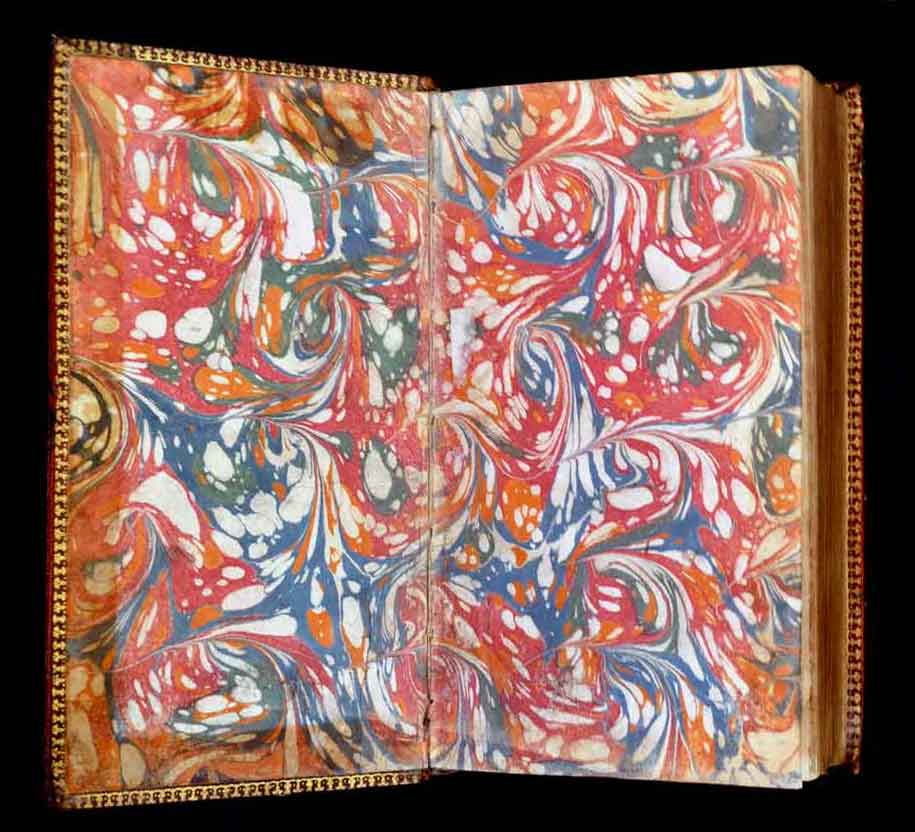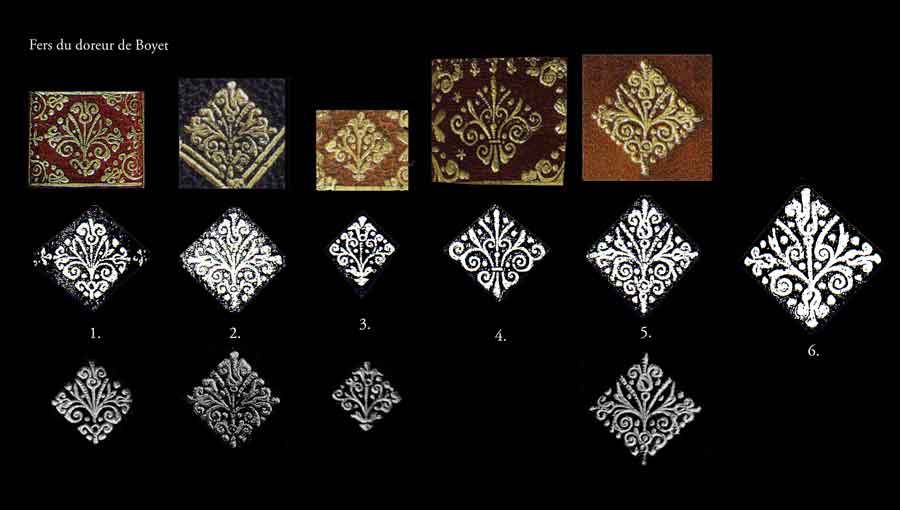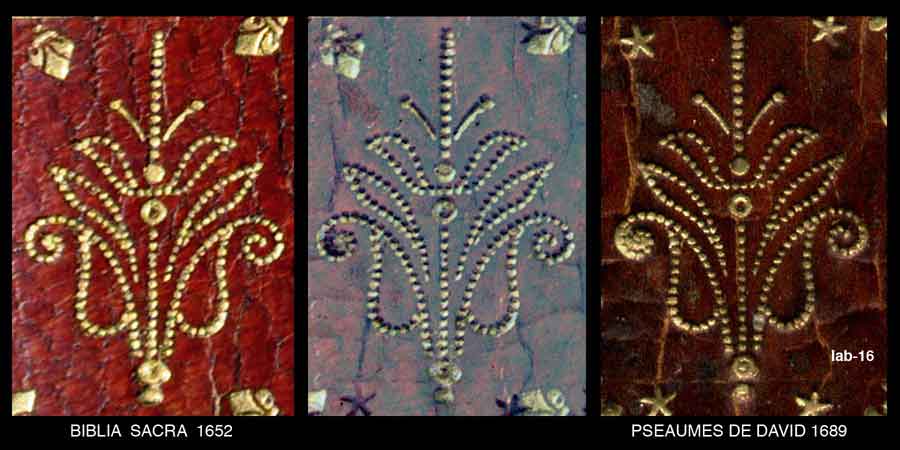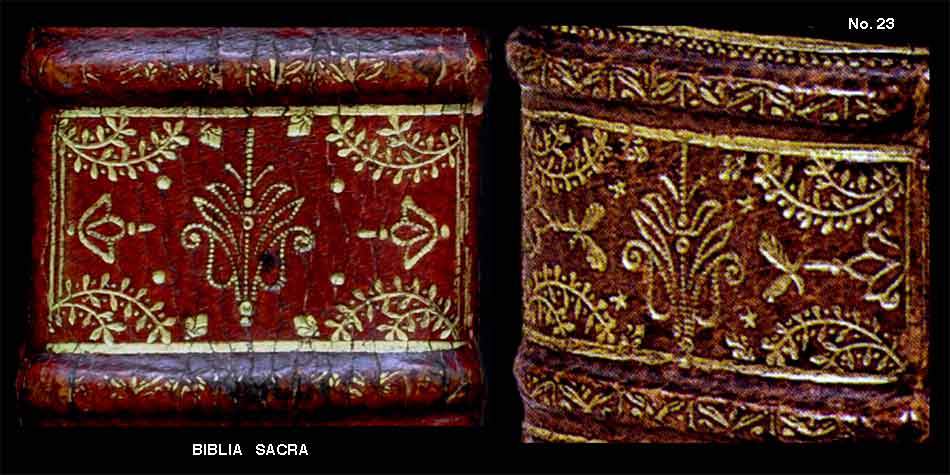


| These Boyet bindings à la Du Seuil were up for auction recently on eBay (October 23, 2010). The seller had only 4 of the eight volumes that normally make up this set, and decided to sell them separately. His photos were limited but good enough for one to recognize the imprints of Boyet's tools. I should have tried to get them all but decided to just concentrate on the first and last volumes of the set which appeared in better condition and with the added plus of a slight variation in the tools used in the spine compartments. I was the only bidder on these two volumes and got both for a rock bottom price. Now that they have arrived we can explore the fine details of the tooling and add a few more imprints to the Boyet catalogue. The first and possibly most important is the large fleuron used in the corners of the inner filet framework of the boards. Isabelle de Conihout & Pascal Ract-Madoux, have illustrated with rubbings 6 similar imprints that derive from Boyet's tools (fers). see page 110 of, Reliures françaises du XVIIe siècle, Isabelle de Conihout & Pascal Ract-Madoux, Paris, 2002. Below in Comparative Diagram 1, I show these rubbings along with some real imprint examples, click to see a 300 dpi enlargement. |


| In Comparative Diagram 2, I show 4 examples of this new fer which we can call provisionally, Boyet fer #7. As part of the bottom of this imprint is partially obscured by another imprint I have shown a number of examples to show that there are two distinct dots at the base of fer #7. Another distinct and important Boyet imprint is lab-16 which I have detailed on another page and show here in Comparative Diagram 3. In the middler of this diagram I show an overlay, with the lab-16 imprint placed as a semi transparent layer over an imprint taken from a spine compartment of the Biblia Sacra, The color of lab-16 imprint has been inverted to a dark blue, and shifted slightly above the light colored imprint below, this allows us to see that the two imprints are certainly from the same tool even though the lab-16 imprint appears to show some unusual characteristics, i.e. the right side spiral leaf end. Below in Comparative Diagram 4, I show a selection of Boyet spines and the lab-16 imprint. Click on this diagram to see an enlargement. On the smallest spine shown here, the lab-16 imprint appears to lack detail, the pointillé segments barely discernable, notice that there is another tool immediately the right and left of lab-16 in these spine compartments, this tool I have detailed previously (at the bottom of this page), it may be associated with some of the last bindings made by Boyet and suggests a later date for this spine which would be confirmed by the worn state of the lab-16 imprint. If this turns out to be correct, it suggests that Boyet used this tool over a long period, and that the decoration of the spines may have been remained virtually unchanged over a long period. |



| On a previous page , I have reproduced, another Boyet binding (No. 23) which bears the arms of Charles-Henry Comte D'Hoym, the spine compartments of this binding are of a similar size and tooled in a similar way with the pair of double branches (see Comparative Diagram 5). These branches have been identified by Jeanne-Marie Métivier who has written a short paper entitled Luc-Antoine Boyet, relieur de l'Imprimerie royale (1704-1723) which was published in la Revue de la Bibliothèque nationale de France, numéro 12, 2002. Described by her as "un double rameau de feuillage" these branches are a Boyet favorite and appear to be copies of similar tools employed half a century earlier. |
| Click on Comparative Diagram 4 to see these spines enlarged, notice that imprints of palette VII used on the tome labels of the Biblia Sacra, look to be sharper than the other examples, this may be due to a difference in the quality of the leather, or it may indicate that this is an earlier work than the 1689 -1693 examples |



| The doublure shown in Comparative Diagram 7, No. 65 is from the second part (Deuxième Partie) of Raphaël Esmerian's 1972 catalogue. Attributed to Boyet by Esmerian in a binding that is possibly c. 1700. Esmerian's reproduction is not of a quality that will permit a sharply detailed enlargement however the roulette used here is probably the same as that in our Biblia volumes. The imprint of the roulette on the doublure is more complete being positioned well inside, while the Biblia roulette is found framing the outer edge of the board and small fraction of the upper part of it is often missing, thus comparisons are difficult, This is further complicated by the fact that we do not have the exact dimensions of the doublure. In any case we can rest assured that the roulette found in our Biblia Sacra is another important tool to add to our Boyet catalogue. |

| Another important roulette is that which has been used along the board edges as well as on the raised bands. In Comparative Diagram 10, I show a roulette which looks the same, from another binding which may be a Boyet, it is a very close match, click to enlarge this diagram and compare these imprints. You can also compare this with the raised band shown in Comparative Diagram 11. Here we see that the roulette is very similar if not the same. This is a very important roulette as it seems to be found on the raised bands and board edges of many of Boyet's bindings. These decorations are some of the first to get worn off, and are often only just barely visible, and to further complicate matters, it appears that many binders copied these tools and used them in an identical way |

|
See also Luc-Antoine Boyet- Roulettes Type C. go to this page to see an example of Boyet roulette E Luc-Antoine Boyet- Jansenist Binding or return to the Boyet Index Page. |
| information about the author | return to the home page of VIRTUAL BOOKBINDING |